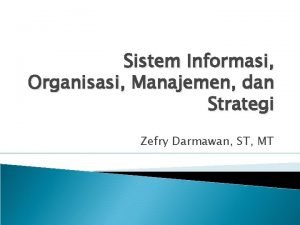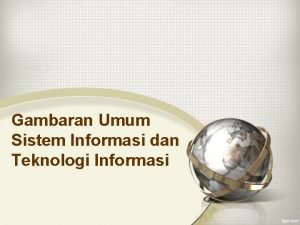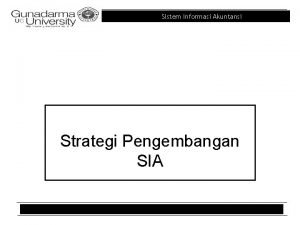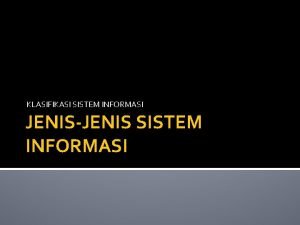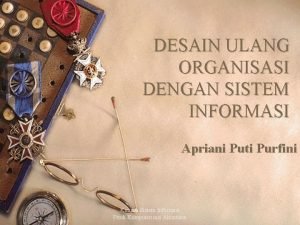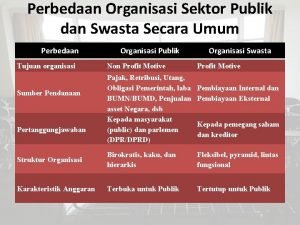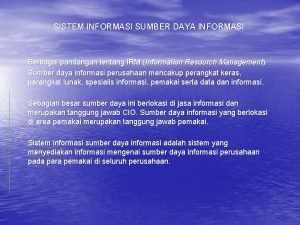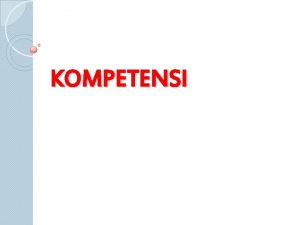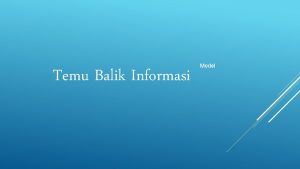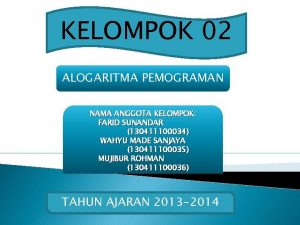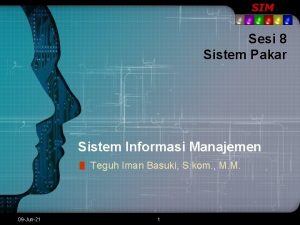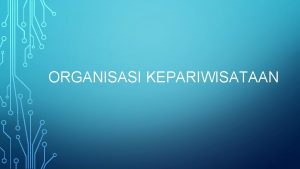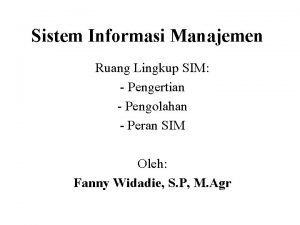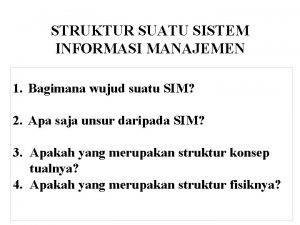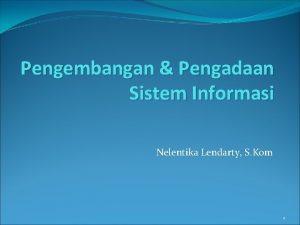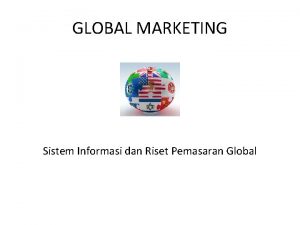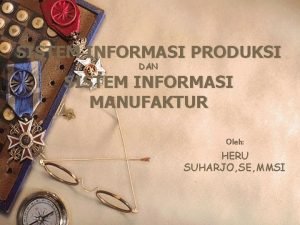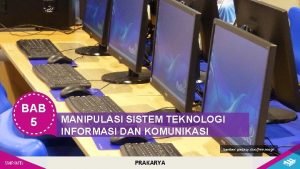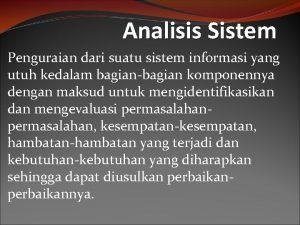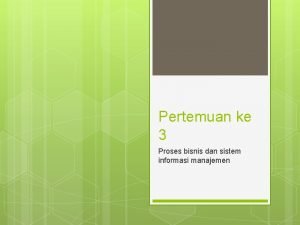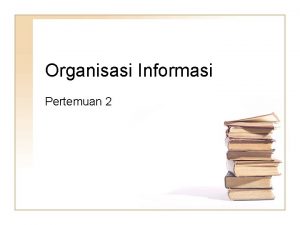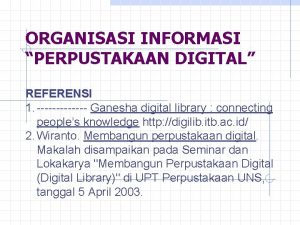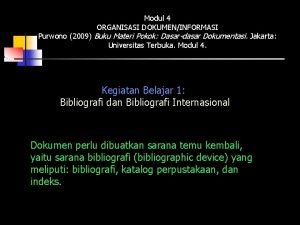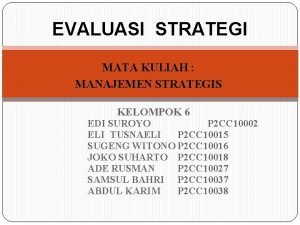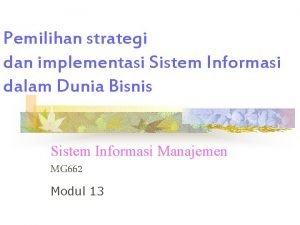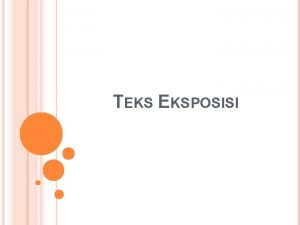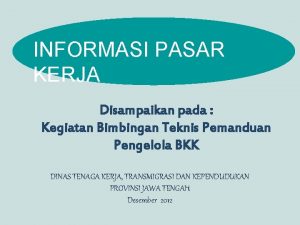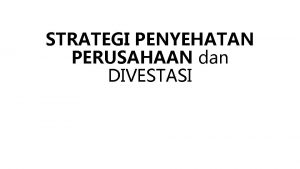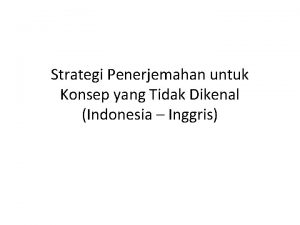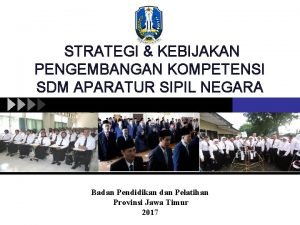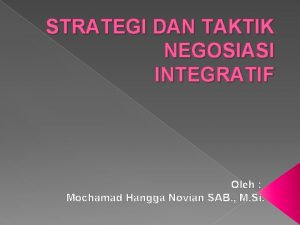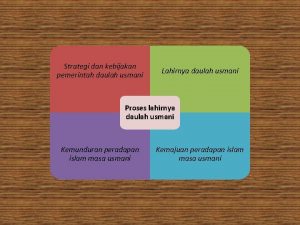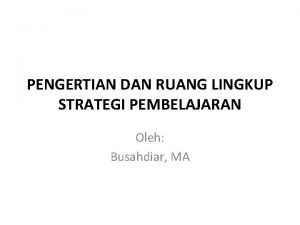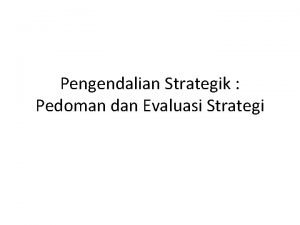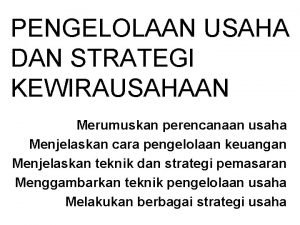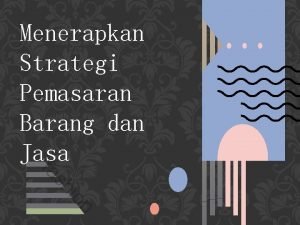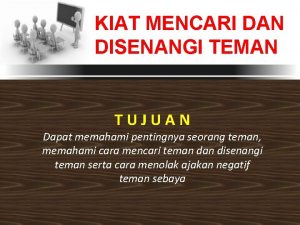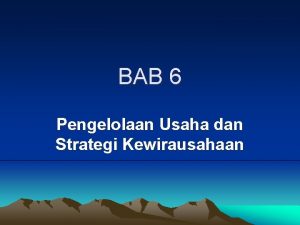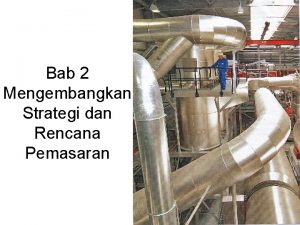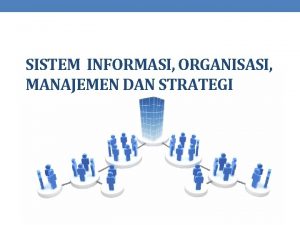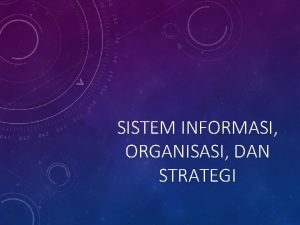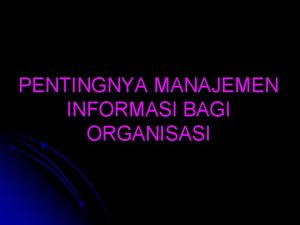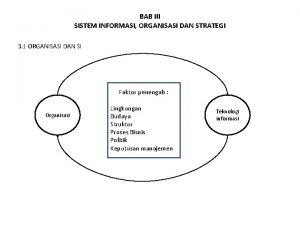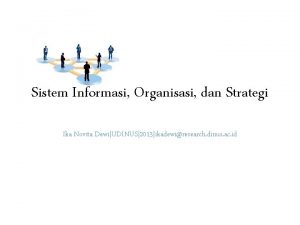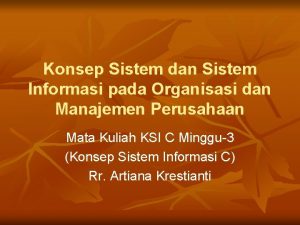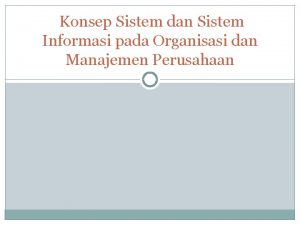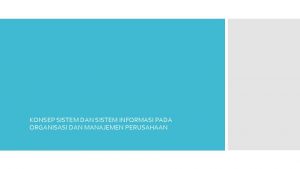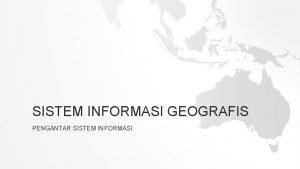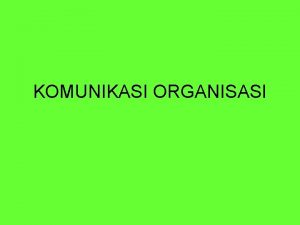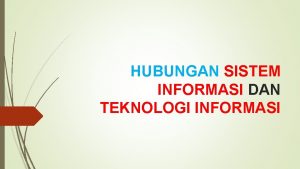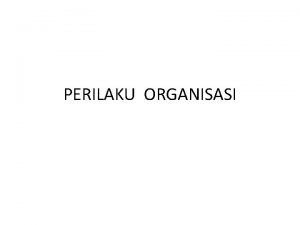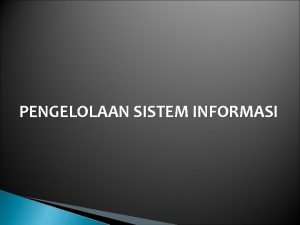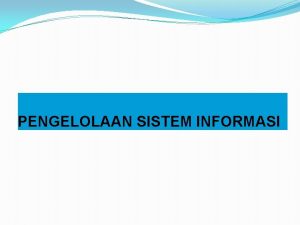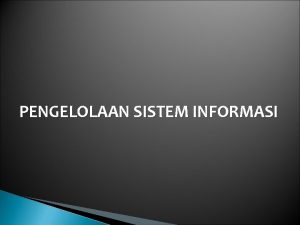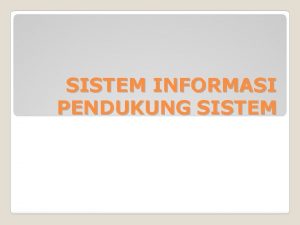SISTEM INFORMASI Sistem Informasi Organisasi dan Strategi Content
















































- Slides: 48

SISTEM INFORMASI Sistem Informasi, Organisasi, dan Strategi

Content • Sistem Informasi di Bisnis Global Saat Ini • E-Bisnis Global dan Kolaborasi • Sistem Informasi, Organisasi, dan Strategi • Isu Sosial dan Etikal dalam Sistem Informasi • Infrastruktur Teknologi Informasi dan Perkembangan Teknologi Baru • Dasar-dasar Business Intelegence: Manajemen database dan Informasi • Telekomunikasi, Internet dan Teknologi Wireless • Sistem Pengaman INformasi • Menuju Penyempurnaan Operasional dan pendekatan pelanggan • E-Commerce : Pasar Digital, Barang Digital • Mengelola pengetahuan dan kolaborasi • Meningkatkan kualitas pembuatan keputusan • Membangun Sistem Informasi • Mengelola Sistem Global

Learning Objectives • Mengidentifikasi dan mendeskripsikan fitur penting dari organisasi bahwa manajer perlu mengetahui dalam membangun dan menggunakan sistem informasi dengan keberhasilan • Menjelaskan bagaimana nilai rantai dan nilai model web membantu bisnis mengidentifikasi peluang untuk aplikasi sistem informasi yang strategis • Menunjukkan bagaimana sistem informasi membantu bisnis menggunakan sinergi, kompetensi pokok, dan strategi berbasis jaringan untuk mencapai keunggulan kompetitif. • Mengukur tantangan yang ditimbulkan oleh sistem informasi strategis dan solusi manajemen.

Organizations and Information Systems • Teknologi informasi dan organisasi saling mempengaruhi • Hubungan dipengaruhi oleh organisasi • Struktur • Proses bisnis • politik • budaya • Lingkungan Hidup • keputusan manajemen

Hubungan Dua Arah Antara Teknologi Informasi dengan Organisasi Hubungan dua arah yang kompleks ini ditengahi oleh banyak factor, bukan keputusan yang dibuat-atau tidak dibuat-manajer. Faktor lain yang menengahi hubungan mencakup budaya organisasi, struktur politik, proses bisnis dan lingkungan bisnis

Organizations and Information Systems • Apa yang dimaksud dengan Organisasi? – Secara teknis: • Struktur sosial formal yang memproses sumber daya dari lingkungan untuk menciptkan hasil • Sebuah badan hukum formal dengan aturan internal dan prosedur, serta struktur sosial – Secara Perilaku: • A collection of rights, privileges, obligations, and responsibilities that is delicately balanced over a period of time through conflict and conflict resolution • Koleksi hak, hak istimewa, kewajiban, dan tanggung jawab yakni keseimbangan yang halus selama periode waktu melalui konflik dan penyelesaian konflik

Definisi Mikroekonomi Teknis dari Organisasi Pada definisi mikroekonomi dari organisasi, modal dan tenaga kerja (factor produksi utama yang disediakan oleh lingkungan) diubah oleh perusahaan melalui proses produksi menjadi barang dan jasa. (output untuk lingkungan). Produk dan jasa tersebut dikonsumsi oleh lingkungan, yang menyediakan persediaan modal dan tenaga kerja lagi sebagai input dalam putaran umpan balik

Sudut Pandang Perilaku Organisasi The behavioral view of organizations emphasizes group relationships, values, and structures.

• Fitur Organisasi • Penggunaan struktur hirarkis • Akuntabilitas, otoritas dalam sistem pengambilan keputusan • Kepatuhan terhadap prinsip efisiensi • Rutinitas dan proses bisnis • Politik organisasi, budaya, lingkungan, dan struktur

• Rutinitas dan proses bisnis • Rutinitas (prosedur operasi standar) • Aturan yang tepat, prosedur, dan praktik yang dikembangkan agar sesuai dengan semua situas yang diharapkan • Proses bisnis: Koleksi rutinitas • Perusahaan bisnis: Koleksi proses bisnis

Rutinitas, Proses Bisnis, dan Perusahaan Seluruh organisasi merupakan kumpulan rutinitas dan perilaku individu, kumpulan menciptakan proses bisnis. Sekumpulan proses bisnis menciptakan organisasi bisnis. Aplikasi sistem informasi yang baru diperlukan untuk mengubah rutinitas dan proses bisnis yang dilakukan oleh individu tersebut guna meningkatkan kinerja organisasi

• Politik Organisasi • Sudut pandang yang berbeda menyebabkan pertarungan politik, persaingan, dan konflik. • Penolakan politik sangat menghambat perubahan organisasi.

• Budaya Organisasi: • Meliputi menetapkan asumsi yang mendefinisikan tujuan dan produk • Produk apa yang harus organisasi hasilkan • Bagaimana dan di mana harus diproduksi • Untuk siapa produk harus diproduksi

• Lingkungan Organisasi • Organisasi dan lingkungan memiliki hubungan timbal balik. • Organisasi terbuka untuk, dan tergantung pada, lingkungan sosial dan fisik. • Organisasi dapat mempengaruhi lingkungan mereka. • Lingkungan umumnya mengubah lebih cepat dari organisasi. • Sistem informasi dapat menjadi alat scanning lingkungan, bertindak sebagai lensa.

Lingkungan dan Organisasi memiliki hubungan timbal balik Lingkungan membentuk apa yang dapat dilakukan perusahaan, tetapi organisasi dapat memengaruhi lingkungannya dan memutuskan mengubah lingkungannya sekaligus. Teknologi informasi memainkan peranan penting dalam membantu organisasi memrsepsikan perubahan lingkungannya dan bertindak bagi lingkungan

• Teknologi yang Mengganggu(distruptive Technologies) • Technology that brings about sweeping change to businesses, industries, markets • Examples: personal computers, word processing software, the Internet, the Page. Rank algorithm • First movers and fast followers • First movers—inventors of disruptive technologies • Fast followers—firms with the size and resources to capitalize on that technology

• 5 dasar jenis struktur organisasi –Entrepreneurial: • Small start-up business –Birokrasi mesin: • Midsize manufacturing firm –Birokrasi terbagi: • Fortune 500 firms –Birokrasi Professional : • Law firms, school systems, hospitals –Adhokrasi • Consulting firms

• Other organizational features –Goals • Coercive, utilitarian, normative, and so on –Constituencies –Leadership styles –Tasks –Surrounding environments

Bagaimana Dampak Sistem Informasi Bagi Organisasi dan Perusahaan Bisnis • Dampak Ekonomi –IT changes relative costs of capital and the costs of information –Information systems technology is a factor of production, like capital and labor –IT affects the cost and quality of information and changes economics of information • Information technology helps firms contract in size because it can reduce transaction costs (the cost of participating in markets) –Outsourcing

Bagaimana Dampak Sistem Informasi Bagi Organisasi dan Perusahaan Bisnis • Teori biaya transaksi • Firms seek to economize on transaction costs (the costs of participating in markets). • Vertical integration, hiring more employees, buying suppliers and distributors • IT lowers market transaction costs for firm, making it worthwhile for firms to transact with other firms rather than grow the number of employees.

Bagaimana Dampak Sistem Informasi Bagi Organisasi dan Perusahaan Bisnis • Teori Keagenan: –Firm is nexus of contracts among self-interested parties requiring supervision. –Firms experience agency costs (the cost of managing and supervising) which rise as firm grows. –IT can reduce agency costs, making it possible for firms to grow without adding to the costs of supervising, and without adding employees.

Bagaimana Dampak Sistem Informasi Bagi Organisasi dan Perusahaan Bisnis • Dampak bagi Struktur dan Perilaku Organisasi –IT Meratakan Organisasi • Decision making is pushed to lower levels. • Fewer managers are needed (IT enables faster decision making and increases span of control). –Organisasi Pasca Industri • Organizations flatten because in postindustrial societies, authority increasingly relies on knowledge and competence rather than formal positions.

IT Meratakan Organisasi Sistem informasi dapat mengurangi jumlah tingkatan dalam organisasi dengan memberikan informasi kepada para manajer untuk mengawasi sejumlah besar karyawan dan memberikan wewenang lebih besar untuk mengambil keputusan kepada karyawan tingkat lebih rendah

Bagaimana Dampak Sistem Informasi Bagi Organisasi dan Perusahaan Bisnis • Memahami Penolakan Organisasi terhadap Perubahan • Information systems become bound up in organizational politics because they influence access to a key resource—information. • Information systems potentially change an organization’s structure, culture, politics, and work. • Most common reason for failure of large projects is due to organizational and political resistance to change.

ORGANIZATIONAL RESISTANCE AND THE MUTUALLY ADJUSTING RELATIONSHIP BETWEEN TECHNOLOGY AND THE ORGANIZATION Implementing information systems has consequences for task arrangements, structures, and people. According to this model, to implement change, all four components must be changed simultaneously.

How Information Systems Impact Organizations and Business Firms • Internet dan Organisasi • The Internet increases the accessibility, storage, and distribution of information and knowledge for organizations. • The Internet can greatly lower transaction and agency costs. • Example: Large firm delivers internal manuals to employees via a corporate Web site, saving millions of dollars in distribution costs

Bagaimana Dampak Sistem Informasi Bagi Organisasi dan Perusahaan Bisnis • Faktor utama organisasi dalam menentukan perencanaan suatu sistem baru: – Environment – Structure • Hierarchy, specialization, routines, business processes – Culture and politics – Type of organization and style of leadership – Main interest groups affected by system; attitudes of end users – Tasks, decisions, and business processes the system will assist

Menggunakan Sistem Informasi untuk Mencapai Keunggulan Kompetitif • Why do some firms become leaders in their industry? • Michael Porter’s competitive forces model • Provides general view of firm, its competitors, and environment • Five competitive forces shape fate of firm: 1. 2. 3. 4. 5. Pesaing Tradisional Pendatang baru di pasar Produk dan Jasa Pengganti Pelanggan Pemasok

Model Daya Kompetitif Porter Dalam Model Daya Kompetitif Porter, posisi strategis perusahaan dan strateginya ditentukan tidak hanya oleh persaingan dengan pesaing langsung tradisionalnya, tetapi juga oleh empat kekuatan dalam lingkungan: pemain baru di pasar, produk pengganti, konsumen dan pemasok

Menggunakan Sistem Informasi untuk Mencapai Keunggulan Kompetitif • Pesaing Tradisional – All firms share market space with competitors who are continuously devising new products, services, efficiencies, and switching costs. • Pendatang Baru di Pasar – Some industries have high barriers to entry, for example, computer chip business. – New companies have new equipment, younger workers, but little brand recognition.

Menggunakan Sistem Informasi untuk Mencapai Keunggulan Kompetitif • Produk dan Jasa Pengganti • Substitutes customers might use if your prices become too high, for example, i. Tunes substitutes for CDs • Pelanggan • Can customers easily switch to competitor’s products? Can they force businesses to compete on price alone in transparent marketplace? • Pemasok • Market power of suppliers when firm cannot raise prices as fast as suppliers

Menggunakan Sistem Informasi untuk Mencapai Keunggulan Kompetitif • Four generic strategies for dealing with competitive forces, enabled by using IT: –Biaya Kepemimpinan/Manajemen yang Rendah –Diferensiasi Produk –Fokus pada Ceruk pasar –Memperkuat Keakraban dengan Pelanggan dan Pemasok

Menggunakan Sistem Informasi untuk Mencapai Keunggulan Kompetitif • Biaya Kepemimpinan/Manajemen yang Rendah • Produce products and services at a lower price than competitors • Example: Walmart’s efficient customer response system • Diferensiasi Produk • Enable new products or services, greatly change customer convenience and experience • Example: Google, Nike, Apple • Mass customization

Menggunakan Sistem Informasi untuk Mencapai Keunggulan Kompetitif • Fokus pada Ceruk pasar • Use information systems to enable a focused strategy on a single market niche; specialize • Example: Hilton Hotels’ On. Q system • Memperkuat Keakraban dengan Pelanggan dan Pemasok • Use information systems to develop strong ties and loyalty with customers and suppliers • Increase switching costs • Example: Netflix, Amazon

Menggunakan Sistem Informasi untuk Mencapai Keunggulan Kompetitif • Dampak Internet pada Daya Kompetitif dan Struktur Industri • Transformation or threat to some industries • Examples: travel agency, printed encyclopedia, media • Competitive forces still at work, but rivalry more intense • Universal standards allow new rivals, entrants to market • New opportunities for building brands and loyal customer bases

Menggunakan Sistem Informasi untuk Mencapai Keunggulan Kompetitif • Model Rantai Nilai Organisasi –Firm as series of activities that add value to products or services –Highlights activities where competitive strategies can best be applied • Primary activities vs. support activities –At each stage, determine how information systems can improve operational efficiency and improve customer and supplier intimacy –Utilize benchmarking, industry best practices

THE VALUE CHAIN MODEL Gambar ini memberikan contoh sistem dari aktivitas utama dan aktivitas dukungan sebuah perusahaan dan nilai mitra ini dapat menambahkan margin nilai untuk perusahaan produk atau jasa

Using Information Systems to Achieve Competitive Advantage • Nilai web: –Collection of independent firms using highly synchronized IT to coordinate value chains to produce product or service collectively –More customer driven, less linear operation than traditional value chain

THE VALUE WEB Value web adalah sistem jaringan yang dapat menyamankan rantai nilai pada mitra bisnis dalam sebuah industi untuk menanggapi secara cepat perubahan dalam pasokan dan permintaan

Using Information Systems to Achieve Competitive Advantage • Information systems can improve overall performance of business units by promoting synergies and core competencies –Synergies • When output of some units used as inputs to others, or organizations pool markets and expertise • Example: merger of Bank of NY and JPMorgan Chase • Purchase of You. Tube by Google

Using Information Systems to Achieve Competitive Advantage • Core competencies • Activity for which firm is world-class leader • Relies on knowledge, experience, and sharing this across business units • Example: Procter & Gamble’s intranet and directory of subject matter experts

Using Information Systems to Achieve Competitive Advantage • Network-based strategies • Take advantage of firm’s abilities to network with each other • Include use of: • Network economics • Virtual company model • Business ecosystems

Using Information Systems to Achieve Competitive Advantage • Traditional economics: Law of diminishing returns –The more any given resource is applied to production, the lower the marginal gain in output, until a point is reached where the additional inputs produce no additional outputs • Network economics: –Marginal cost of adding new participant almost zero, with much greater marginal gain –Value of community grows with size –Value of software grows as installed customer base grows

Using Information Systems to Achieve Competitive Advantage • Virtual company strategy –Virtual company uses networks to ally with other companies to create and distribute products without being limited by traditional organizational boundaries or physical locations –Example: Li & Fung manages production, shipment of garments for major fashion companies, outsourcing all work to more than 7, 500 suppliers

Using Information Systems to Achieve Competitive Advantage • Business ecosystems • Industry sets of firms providing related services and products • Microsoft platform used by thousands of firms • Walmart’s order entry and inventory management • Keystone firms: Dominate ecosystem and create platform used by other firms • Niche firms: Rely on platform developed by keystone firm • Individual firms can consider how IT will help them become profitable niche players in larger ecosystems

AN ECOSYSTEM STRATEGIC MODEL Era film digital memerlukan sebuah pandangan yang lebih dinamis mengenai batas-batas diantara industry, perusahaan, pelanggan, dan pemasok, beserta dengan persaingan yang terjadi di antara industry dalam ekosistem bisnis. Dalam model ekosistem, beberapa industry bekerja sama untuk memberikan nilai kepada pelanggan. TI memainkan peran penting dalam memungkinkan jaringan padat interaksi antara perusahaan yang berpartisipasi

Using Information Systems for Competitive Advantage: Management Issues • Sustaining competitive advantage • Competitors can retaliate and copy strategic systems • Systems may become tools for survival • Aligning IT with business objectives • Performing strategic systems analysis • Structure of industry • Firm value chains • Managing strategic transitions • Adopting strategic systems requires changes in business goals, relationships with customers and suppliers, and business processes

References • Laudon, Kenneth C, dan Jane P. Loudon, 2014, Management Informaton System : Managing the Digital Firm, 13 th edition, Upper Sadle River, New Jersey : Prentice Hall
 Sistem informasi organisasi manajemen dan strategi
Sistem informasi organisasi manajemen dan strategi Gambaran umum sistem informasi manajemen
Gambaran umum sistem informasi manajemen Software sia
Software sia Strategi sistem informasi terkait daya kompetitif
Strategi sistem informasi terkait daya kompetitif Management information system structure
Management information system structure Contoh klasifikasi informasi
Contoh klasifikasi informasi Desain ulang organisasi dengan sistem informasi
Desain ulang organisasi dengan sistem informasi Perbedaan sektor publik dan sektor swasta
Perbedaan sektor publik dan sektor swasta Sistem informasi sumber daya informasi
Sistem informasi sumber daya informasi Carrier content vs real content
Carrier content vs real content Dynamic content vs static content
Dynamic content vs static content Kompetensi berdasarkan kinerja intrinsik
Kompetensi berdasarkan kinerja intrinsik Judul dan nama anggota kelompok informasi gambar informasi
Judul dan nama anggota kelompok informasi gambar informasi Judul dan nama anggota kelompok informasi gambar informasi
Judul dan nama anggota kelompok informasi gambar informasi Sistem pakar dalam sistem informasi manajemen
Sistem pakar dalam sistem informasi manajemen Organisasi kepariwisataan
Organisasi kepariwisataan Ruang lingkup sistem informasi
Ruang lingkup sistem informasi Wujud sistem informasi manajemen
Wujud sistem informasi manajemen Pengembangan dan pengadaan sistem informasi
Pengembangan dan pengadaan sistem informasi Sistem informasi pemasaran global
Sistem informasi pemasaran global Subsistem dari sistem informasi produksi
Subsistem dari sistem informasi produksi Manipulasi sistem teknologi informasi dan komunikasi
Manipulasi sistem teknologi informasi dan komunikasi Contoh desain input dan output sistem informasi
Contoh desain input dan output sistem informasi Proses bisnis dan sistem informasi
Proses bisnis dan sistem informasi Etika dan isu sosial dalam sistem informasi
Etika dan isu sosial dalam sistem informasi Struktur organisasi layanan informasi
Struktur organisasi layanan informasi Organisasi informasi adalah
Organisasi informasi adalah Makalah organisasi informasi perpustakaan
Makalah organisasi informasi perpustakaan Modul organisasi informasi
Modul organisasi informasi Evaluasi strategi
Evaluasi strategi Sistem pemilihan strategi
Sistem pemilihan strategi Memaparkan atau menjelaskan informasi
Memaparkan atau menjelaskan informasi Informasi pasar kerja
Informasi pasar kerja Strategi pengajaran dan pembelajaran
Strategi pengajaran dan pembelajaran Strategi penyehatan perusahaan dan divestasi
Strategi penyehatan perusahaan dan divestasi Strategi penerjemahan dan contohnya
Strategi penerjemahan dan contohnya Strategi kebijakan pengembangan kompetensi asn
Strategi kebijakan pengembangan kompetensi asn Strategi dan taktik negosiasi integratif
Strategi dan taktik negosiasi integratif Strategi pemerintahan daulah usmani
Strategi pemerintahan daulah usmani Ruang lingkup strategi belajar mengajar
Ruang lingkup strategi belajar mengajar Contoh pengendalian strategis
Contoh pengendalian strategis Siklus hidup produk sunlight
Siklus hidup produk sunlight Contoh pengelolaan usaha
Contoh pengelolaan usaha Mengembangkan program dan strategi penetapan harga
Mengembangkan program dan strategi penetapan harga Menerapkan strategi pemasaran barang dan jasa
Menerapkan strategi pemasaran barang dan jasa Sebutkan strategi mencari teman dan disenangi teman
Sebutkan strategi mencari teman dan disenangi teman Strategi portofolio pasif
Strategi portofolio pasif Pengertian strategi kewirausahaan
Pengertian strategi kewirausahaan Pertanyaan tentang konsep pemasaran
Pertanyaan tentang konsep pemasaran
